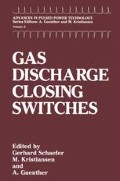Abstract
All spark gaps will “break down” or transition from the insulating state to the conducting state, if the voltage across the gap is increased above the gap self breakdown voltage. The self breakdown voltage for a uniform field and a given gap spacing, gas specie and pressure, electrode material, dielectric environment, and ambient radiation environment is commonly described by the Paschen curve as discussed in Chapter 2. However, actual spark gaps do not commonly have uniform fields and must operate for many discharges with a gas dielectric mixture in a manner that is not well defined. Therefore, the uniform field Paschen curves are used to define an initial design and empirical breakdown behavior are obtained to define the actual gap operating range.
Access this chapter
Tax calculation will be finalised at checkout
Purchases are for personal use only
Preview
Unable to display preview. Download preview PDF.
References
Bryant, M.O., and Yune, Y.G., 1987, The Complete Temperature Field in Carbon Graphite Electrical Brushes Due to Frictional and Electrical Power Dissipation, Proc. 1987 Int. Current Collector Conf., Balcones Research Center, Austin, TX.
Butkevich, G.V., Belkin, G.S., Vedenshenkov, N.A., and Zhavoronkov, M.A., 1978, Electrical Erosion in High-Current Contacts and Electrodes, M. Energy.: 1-256.
Comstock, W.D. and Williams, E.M., 1959, Current Distribution in the Cylindrical Source Plane-Electrode Configuration, AIEE Trans., 78:252.
Dethlefsen, R., 1968, Investigation of Electrode Erosion in High Current Arcs, Aerospace Research Laboratories Report # 68-0112.
Donaldson, A.L. and Kristiansen, M., 1989, Electrode Erosion as a Function of Electrode Materials in High Current, High Energy Transient Arcs, Proc. of 7th IEEE Pulsed Power Conference, Monterey, CA,:83.
Donaldson, A.L., 1990, Electrode Erosion in High Current, High Energy Transient Arcs, Ph.D Dissertation. Texas Tech University.
Felsenthal, P. and Proud, J.M., 1965, Nanosecond Pulse Breakdown in Gases, Phys. Rev., 139:1796.
Goloveiko, A.G., 1967, Pulsed Action of Intense Heat Fluxes and Volume Heat Sources on Metals, J. Eng. Phys., 12:124.
Martin, J.C., 1965, Duration of the Resistive Phase and Inductance of Spark Channels, AWRE Switching Notes, 5:25.
Martin, J.C., 1967, Dielectric Strength Notes, United Kingdom Atomic Research Establishment, 15.
Martin, T.H., 1985, Pulsed Charged Gas Breakdown, Proc. 5th IEEE Pulsed Power Conference, Arlington, VA,:74.
Martin, T.H., 1988, Voltage Breakdown Scaling, J. Appl. Phys., 35:578.
Pendleton, W.K. and Guenther, A.H., 1965, Investigation of a Laser Triggered Spark Gap, Rev, of Sei. Instr., 36:1546.
Rich, J.A., 1961, Resistance Heating in the Arc Cathode Spot Zone, J. Appl Phys., 32:1023.
Shkuropat, P.I., 1969, Investigation of Preignition Processes in Trigatrons Operating in Air, Sov. Phys.-Tech.Phys., 14:1256
Sorensen, T.P. and Ristic, V.M., 1977, Rise-time and Time Dependent Spark Gap Resistance in Nitrogen and Helium, J. Appl. Phys.. 48:114.
Udo, T., 1965, “Attenuation and Distortion of Short Tail Traveling Waves on Overhead Power Transmission Lines”, IEEE Trans, on Power Systems and Apparatus. PAS-84:304.
Watson, A., 1986, Contribution to Annual Technical Report, SDI Power Conditioning Contract #DNA 001-85-C-0184.
Author information
Authors and Affiliations
Editor information
Editors and Affiliations
Rights and permissions
Copyright information
© 1990 Springer Science+Business Media New York
About this chapter
Cite this chapter
Nunnally, W.C., Donaldson, A.L. (1990). Self Breakdown Gaps. In: Schaefer, G., Kristiansen, M., Guenther, A. (eds) Gas Discharge Closing Switches. Advances in Pulsed Power Technology, vol 2. Springer, Boston, MA. https://doi.org/10.1007/978-1-4899-2130-7_3
Download citation
DOI: https://doi.org/10.1007/978-1-4899-2130-7_3
Publisher Name: Springer, Boston, MA
Print ISBN: 978-1-4899-2132-1
Online ISBN: 978-1-4899-2130-7
eBook Packages: Springer Book Archive

